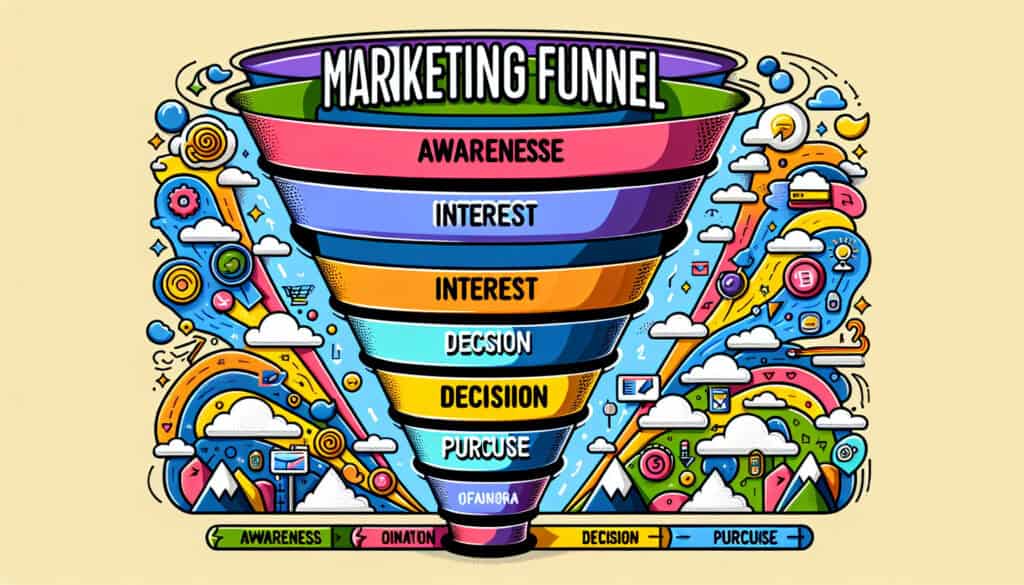To visualize the customer journey from awareness to purchase.
- Metodologie: Clienti e marketing, Economia, Risorse umane, Gestione del progetto
Imbuto di marketing

Imbuto di marketing
- Tasso di conversione, Esperienza del cliente, Mappatura del viaggio del cliente, Marketing, Strategia di marketing, Esperienza utente (UX), Progettazione incentrata sull'utente, Proposta di valore, Mappatura del flusso di valore
Obiettivo:
Come si usa:
- A model that illustrates the theoretical customer journey towards the purchase of a good or service. The funnel is divided into several stages, such as awareness, interest, consideration, and conversion.
Professionisti
- Provides a simple and intuitive way to understand the customer journey; Helps to identify areas where customers are dropping off.
Contro
- Can be too simplistic and may not reflect the non-linear nature of the customer journey; Focuses more on acquisition than retention.
Categorie:
- Clienti e marketing
Ideale per:
- Understanding and optimizing the customer journey to increase conversion rates.
Applications of the Marketing Funnel can be found across numerous sectors, including technology, retail, healthcare, and education, where understanding consumer behavior is paramount for driving sales and enhancing customer experiences. Typically utilized during the product development and marketing phases, this model encourages teams to examine each stage in depth, offering a clearer view of where strategic adjustments can increase buyer engagement and conversion rates. For instance, in the tech industry, a product team may employ the funnel model to analyze how potential users first learn about a new app, the content that piques their interest, and the factors influencing their decision-making process before committing to download. Participants in this exercise often include marketing strategists, product managers, and UX designers, all working collaboratively to establish effective communication and marketing strategies at each stage. The simplicity of the funnel allows stakeholders to visualize customer interactions effectively, revealing specific drop-off points—such as a website’s checkout page—where potential consumers lose interest, enabling targeted improvements that can significantly boost sales performance. By integrating analytics tools with the funnel methodology, organizations gain quantitative data that can refine campaigns and enhance user outreach across various platforms.
Fasi chiave di questa metodologia
- Define target audience segments based on demographics and behavior.
- Develop strategies for generating awareness through various marketing channels.
- Create engaging content that captures interest and builds a relationship with potential customers.
- Implement tactics that facilitate consideration, such as product comparisons and case studies.
- Optimize conversion through effective calls-to-action and streamlined purchase processes.
- Analyze post-purchase experience to encourage repeat business and referrals.
Suggerimenti per i professionisti
- Leverage data analytics to continuously monitor conversion rates across each stage and identify drop-off points for targeted intervention.
- Implement A/B testing at various stages to refine messaging, visuals, and calls to action that resonate most with customers.
- Utilize customer feedback loops post-purchase to understand their experience and inform iterative improvements on the funnel stages.
Leggere e confrontare diverse metodologie, raccomandiamo il
> Ampio archivio di metodologie <
insieme ad altre 400 metodologie.
I vostri commenti su questa metodologia o ulteriori informazioni sono benvenuti su sezione commenti qui sotto ↓ , così come tutte le idee o i link relativi all'ingegneria.
Contesto storico
1960
1980
1983
1990
1994
1995
2000
1950
1980
1980
1986
1992
1995
2000
2002-05-01
(se la data non è nota o non è rilevante, ad esempio "meccanica dei fluidi", viene fornita una stima approssimativa della sua notevole comparsa)















Post correlati
Simulazione di Monte Carlo
Test basati su modelli
Controllo del modello
Ricerca con metodi misti
A prova di errore (Poka-Yoke)
Test del profilo di missione